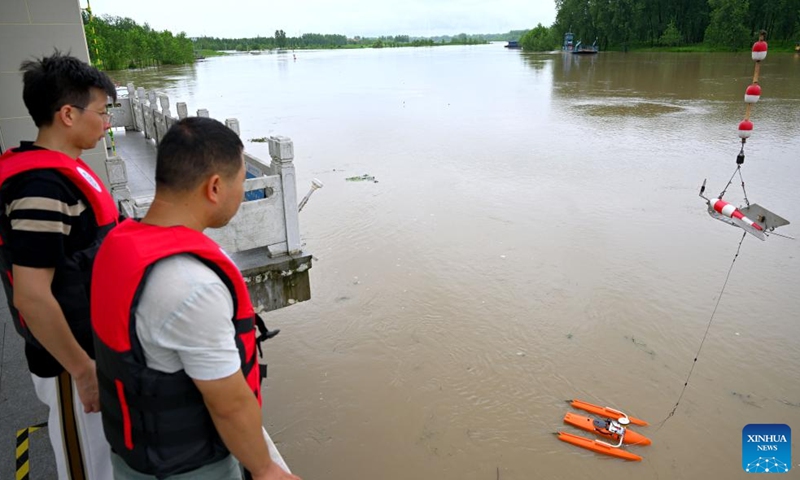China fully activates flood prevention mechanism during critical season

Staff members monitor the flood water at a hydrological station in Funan County of Fuyang, east China's Anhui Province, July 14, 2024. Measures including monitoring the flood water, inspecting embankments, and ensuring flood-control materials have been taken by the authorities of Funan County of Fuyang, east China's Anhui Province, to control the "No. 1 Flood" for Huaihe River. (Photo: Xinhua)
China has fully activated a flood prevention mechanism, highlighting efforts in closely forecasting, monitoring, and early warning of the weather and water conditions, as the country enters the annual critical flood crest season from Tuesday to mid-August.
According to the Ministry of Water Resources, on Tuesday, the water levels in the mainstream of the middle and lower reaches of the Yangtze River continue to rise. Due to rainfall and upstream water inflow, 75 rivers in 10 provinces and regions including Anhui, Henan, Xinjiang, and Heilongjiang have experienced floods above national warning levels.
On Tuesday evening, the ministry launched a Level IV emergency response for flood prevention in Shandong and Henan provinces, sending two working groups to Shandong and Henan to guide the prevention of torrential rains and floods.
To gear up for the critical flood season, on Sunday, the Ministry of Water Resources held a press briefing to detail current arrangements.
According to the press briefing, four major risks are being closely monitored – the possibility of flooding in all seven major river basins; localized heavy rainfall could easily trigger flooding in small to medium-sized rivers, flash floods, and urban waterlogging; the large number of small to medium-sized reservoirs, dangerous reservoirs, and silted dams have limited capacity to withstand floods; with many water conservancy projects underway this year, some projects require construction during the flood season, increasing the risk of safety during construction.
The ministry said it will prioritize prevention, conduct timely, and accurate monitoring, forecasting, and early warning of flood situations. It stressed unified joint scheduling of control water projects in the basin to maximize overall effectiveness. Also, the ministry emphasized focusing on inspecting and defending high-risk and weak sections of embankments and dangerous areas with special attention to night patrols.
The press briefing noted that authorities will prioritize the evacuation of residents in high-risk areas, promptly relocating people in case of danger or potential risks to ensure the safety of the population.
Current weather forecasts show that over the next week, there will still be continuous heavy rainfall across the upper reaches of the Yangtze River. In order to cope with the subsequent possible major floods in the upper reaches of the Yangtze River and ensure flood control safety, Chinese authorities plan to seize the limited interval of heavy rainfall in mid-to-late July to speed up the reduction of water levels in the Three Gorges Dam, so that the reservoir can spare enough flood control storage capacity and prepare for the possible major floods during this critical period.
The Three Gorges Dam started flood discharges on July 10 to open up more capacity for incoming floods from the upper reaches of the Yangtze River, in Central China's Hubei Province, Xinhua News Agency reported.
According to the current situation of the Three Gorges Dam maintaining 43,000 cubic meters per second discharge and upstream water, there is no risk of flooding in the reservoir area in the near future, the Changjiang Water Resources Commission under the Ministry of Water Resources said on Tuesday via its WeChat account.
However, individual foreign media outlets have tried to smear the function and effects of the reservoirs. In response, Chinese insiders emphasized the critical role of reservoirs in flood control and prevention during the flood season.
They explained that the effectiveness of reservoirs in flood control and prevention in China varies depending on factors such as the size of the reservoir, its location, and the amount of rainfall. In general, larger reservoirs with better management systems tend to perform well in flood control.
Ma Jun, director of the Beijing-based Institute of Public and Environmental Affairs, told the Global Times on Tuesday that in China, there are a large number of small to medium-sized reservoirs in mountainous areas, many of which were built during the middle of the last century. These reservoirs are quite old, and some were not built to very high standards initially, resulting in a large number of unsafe reservoirs.
In recent years, the Chinese government has invested heavily in improving the infrastructure and management of reservoirs to enhance their effectiveness in flood control and prevention. This includes implementing early warning systems, improving dam safety standards, and conducting regular maintenance and inspections.
Against the backdrop of global climate change leading to more extreme rainfall, there is significant pressure on small to medium-sized reservoirs in less-developed areas, Ma noted.
Therefore, this year the water resources authorities have emphasized small to medium-sized reservoirs should operate with empty storage. Once rainfall arrives, they should not continue to operate at high water levels but rather have more space to prepare for incoming floods.
On the other hand, the large backbone reservoirs built after the reform and opening up generally have higher standards and can play a significant role in flood prevention, Ma said.
He noted while reservoirs in China have made significant contributions to flood control and prevention, there is still room for improvement to ensure their effectiveness in mitigating the impact of floods.
Photos
Related Stories
- Funan County in E China takes measures to control flood for Huaihe River
- China issues alerts for flooding amid summer heat
- Rescue efforts underway in Chongqing after heavy rainfall
- China's Yangtze River sees second flood of 2024
- China beefs up efforts for flood control, disaster relief
- China gears up for critical flood crest season
Copyright © 2024 People's Daily Online. All Rights Reserved.









